- Home
- Peter Matthiessen
The Cloud Forest Page 4
The Cloud Forest Read online
Page 4
“Its capacities for trade and commerce are inconceivably great,” wrote Lieutenant William Herndon in 1851, in the journal of his survey of the Amazon for the United States Navy Department. “Its industrial future is the most dazzling; and to the touch of steam, settlement and cultivation, this rolling stream and its magnificent watershed would start up into a display of industrial results that would indicate the Valley of the Amazon as one of the most enchanting regions on the face of the earth.” Herndon’s optimism was shared by many who came after, but the Amazon remains as sullen and intractable as it ever was; indeed, it is startling to find how exactly the descriptions of Herndon and such contemporaries as the great naturalist H. W. Bates and the botanist Richard Spruce correspond with the appearance of the river as it is today. The few large towns excepted, the traveler on the Amazon sees almost precisely what these men saw a century ago.
But this is my first day on the river, and the atmosphere is exhilarating, not oppressive. Man has literally scratched the surface of this enormous world, which recedes and approaches endlessly as the ship moves through it—in time of full flood, according to some accounts, the river may become so wide that one is out of sight of land, though this seems doubtful—and the scratches heal quickly in this wild climate without winter. Both the idea and the spectacle are moving—so moving that I could not suppress little squeaks of pure excitement. It is difficult to accept that a wilderness of this dimension still exists, that, despite our airplanes and machines, we cannot really en ter it but only skirt its edges. This will change, of course, but it will change slowly; today, should this ship stop at some arbitrary point and send a small boat to the shore, the chances would still be heavily in one’s favor that no man, dark or white or copper, had ever stood beneath those trees before.
The trees, at noon, are still remote. There are only the high conglomerate mass of growth, and the debris in the silent river, and the sky. At this time of the day the jungle is glazed over, dead. But in the early afternoon, at the mouth of an inlet several hundred yards away, a great fish, one hundred pounds or more, hurls itself out of the water, flaps like a hooked tarpon in the air, and splashes down again, leaving a soft welt on the thick surface. And later, with the coming of the wind, the sun and rain, both having hung back all day, arrive from separate quarters simultaneously. To avoid the main current, we are nearing a narrow side channel, or furo, and moments later, in an incredible light which follows the rain, plunge recklessly into the jungle, our bow wave washing noisily into the stiff arrow reeds on both sides as a small bigua cormorant flees back past us toward the open river. For the first time the forest shows its face—great palms and rubber trees, huge domed ceibas, soaring high out of the tangle of small hardwoods and lianas. The foliage is luminous and alive, and birds flash everywhere—egrets, bright river swallows, a huge woodpecker, hawks silhouetted in the trees, and, farther on, a scattering of exotic clumsy fowl, a sort of burnished brown chachalaca with white shoulder stripes and the pale tail feathers of a grouse—is this the archaic hoatzin? It squawks and thrashes dismally in the high reeds of the bank. At twilight pairs of parrots hurry down the sky above the treetops, their flight trembling and swift. Then sudden darkness, and the jungle is a wall again, a black misshapen silhouette towering above us on both sides, as if the ship were passing down a canyon in the River Styx. It seems to me at this moment, catching my breath, that, even if the jungle should never let me have this fleeting intimacy again, the long journey here will have been worth it.
December 20.
This morning we are approaching the mouth of the Xingú River; somewhere far off there to the southward, toward the headwaters of the Xingú, Colonel P. H. Fawcett, the most famous of South America’s lost explorers, disappeared in 1925, still searching for his lost cities of pre-Incas. “The existence of the old cities I do not for a moment doubt …” he wrote in that last year. “Unfortunately, I cannot induce scientific men to accept even the supposition that there are traces of an old civilization in Brazil. I have travelled much in places not familiar to other explorers, and the wild Indians have again and again told me of the buildings, the character of the people, and the strange things beyond.”
Colonel Fawcett’s explorations in the jungles of Bolivia and Brazil extended from 1903 until 1925, and his journals make lurid reading; violent death, whether by murder, disease, drunkenness, Indians, or animals, is a commonplace on almost every page. Much of the carnage he describes came of the evil consequences of the rubber boom, which spread cruelty and greed throughout the jungles for most of a century, before subsiding around 1912; it was found that transplanted rubber trees could be grown more economically on East Indian plantations, and an industry which had built Manaus and Iquitos, and promised swift development of the Amazon, was reduced to a local harvest of wild trees.
Fawcett claims, no doubt correctly, that few of the Indian tribes were warlike until the white man enslaved, exploited, and murdered them for his own ends. For the most part his accounts are sensible and sympathetic, and it is too bad that their credibility is so often undermined by exaggeration and wishful thinking. While scarcely in a position to dispute Fawcett’s allegations, not having lived with him in the jungle, I find a number of his observations startling, to put it very mildly. His remarks on the size and habits of the anaconda may be taken as a fair sample; he himself destroyed a specimen of sixty-eight feet, which so upset his Indians that “in the moment of firing I had heard their terrified voices begging me not to shoot lest the monster destroy the boat and kill everyone on board, for not only do these creatures attack boats when injured, but also there is great danger from their mates.” Fawcett alleged as well that “their weird cries could be heard at night,” which, if true, would make the anaconda unique in the community of serpents; their breath, he wrote, is stupefying to their prey. (Doubtless the breath of a sixty-eight-foot snake can be a pretty stupefying thing, but any victim close enough to smell it would already be, if not on the point of consumption, at least in fairly parlous straits.)
Fawcett has disciples still, and I attracted them like flies all the way upriver. But since I am doing my best to remain hardheaded, I had better not report their stories here.
At Jariuba Point the Venimos leaves the Pará and swirls into the main channel of the Amazon. Almost immediately, however, she enters the parallel Arrayolos furo, dodging behind the islands to avoid the central current. An hour later we meet our sister ship, the Viajero, bound downriver: she takes aboard our Brazilian pilots, and we take her two Peruvians.
A number of new birds this morning—I am keeping separate notes on them, with some vague hope of future identification—and two more large fish seen finning. Probably this is the pirarucu, an Amazonian relation of the salmons, which reaches a weight of several hundred pounds. There is also the piraiba catfish, said to be capable of swallowing a man whole, though, so far as I know, it has never made the attempt. But the mammals stay out of sight, all but the inia, or Geoffroy’s dolphin, which is common along the banks. The high point of my morning—I spend most of my day on top of the bridge, a vantage point known as “monkey island”—was the spectacle of three glorious swallow-tailed kites, that most striking of all land birds, to my mind, now nearing extinction in North America. I remember well the first and only swallow-tailed kite I have seen before today, east of Naples in southwest Florida, and my maniacal cries of excitement—I was very young then and could still cry out—as it turned and swooped back and forth over my head. (Technically, I suppose, this Amazon kite represents a distinct subspecies or race of the swallow-tailed kite, but I am not equipped to make such fine distinctions; birds essentially identical to our black vulture—the ubiquitous urubu—osprey, and common and snowy egrets are also abundant on this part of the river and shall be referred to by these names, as the old friends they are.)
To the north, in the afternoon, rise the low hills of the Sierra Jutahy. The jungle changes gradually, with the tall palms slowly disappearing. Here t
he silk-cotton, or ceiba, from the pods of which the fiber known as kapok is derived, is the tallest tree among the few I can identify, its outline blurred by blankets of liana vine. A legion of smaller trees crowds everywhere, and from a distance a species of cecropia appears to bear huge silver flowers. This is the imbauba, one of the great number of medicinal trees used by the river people, and its silver flowers are only its great floppy leaves blown over. There are also wild rubber trees and a kind of fig tree, and bignonias which look like the jacaranda. The variety and profusion of species is even more dismaying than among the birds, most of which I can at least identify by family: the hopelessness of attempts at plant identification for anyone but a botanist resides in the fact that the flora of the Amazon basin is the most complex on earth; the majority of all plant species known to man are to be found in this vast forest, and Louis Agassiz once identified one hundred and seventeen distinct woods, including palms, myrtles, laurels, acacias, bignonias, rosewood, cecropias, bombaceas, Brazil-nuts or castanheiras, rubber, fig, and purplehearts, in an area a half-mile square.
A few huts, most of them broken and untenanted, their clearings overgrown and their fish traps sagging in the current. Farther on, some natural savannas, stretching away like park-lands; apparently they are marshy, for they are uninhabited. Hawks are everywhere in astonishing variety, and at twilight the parrots appear again, and a solitary anhinga, marked more vividly than the species in North America, flaps and glides across the river. The air is warmer tonight than last, with the huge sweet smell of the tropics.
December 21.
At daylight Santarém, one of the few towns in the thousand miles between Belém and Manaus, drifts past against the low hills to the south. Here is the mouth of the blue Tapajoz, stopping short as it meets the Amazon as if it had struck a wall, and swallowed without a trace; some distance up the Tapajoz lies Fordlandia, the site of the Ford Company’s great abandoned rubber plantation and of one of man’s more notable failures in attempts at conquest of this region.
More and more the country has changed to open savanna, green and sparkling in the light of this first bright day since the Venimos entered the Amazon—a truly magnificent day. Three brilliant parrots whirl around the sunlit branches of a tall ceiba, and white egrets are everywhere, and a quadrille of dusky skimmers lilts along across the river. These thick meadows are like outposts of a great grassy plain, the Campos Geraes, which lies off to the northward, cut off from man by some two hundred and fifty miles of jungle; the plain extends another two hundred miles to the Tumucumaque highlands on the border of the Guianas. One day there may be a cattle industry in those grasslands, some fifteen thousand square miles of them, like a huge unexplored island in this sea of trees.
Between Santarém and Óbidos, a scant sixty-five miles upriver, man’s presence is quite noticeable. The banks are higher here, and the thatch huts of the caboclos are larger, semi-permanent. Nevertheless, in the nearly three hundred years since Óbidos was founded the face of the river has changed little, and that change is due largely to erosion. At Óbidos, more than six hundred miles from the sea, there is still a one-foot tide. It is a pastel village with Spanish red-tile roofs and looks painted onto its pink sandstone bank; the banks seem inset in turn into the jungle. A church with two towers is built above the town, and the towers sink slowly into the green as the ship moves westward.
December 22.
Last night, toward twilight, I saw the gleaming white head of a kite perched in the dome of a fig tree, and, immediately afterward, two great scarlet macaws, tail feathers streaming, sailed with lazy grace among the cabbage palms along the bank; a third was hauling itself up the trunk of a pale tree with its hooked bill. This morning I saw another in silhouette, and an inia rooting under the bank, and more new birds.
The landscape slowly changes. There are fewer savannas, taller forests, and occasional high red and yellow banks. The ship zigzags back and forth from bank to bank, avoiding the strength of the main current; she stays as close to the bank as possible, and as the river is often fifty feet in depth only a few yards from the shore, this can be very close indeed, so close that branches of the trees at times could be touched with a long fishing pole. With binoculars, and even without, one can study the birds and trees in some detail. (On the downstream run the ship stays in mid-river, and while the trip takes half the time, the river is miles wide in places, and the jungle at best is very remote.) The sole aid to navigation placed on the river since the French geographer La Condamine first mapped it in 1743 is the light on Mandihoy Bank, and the landmarks, such as they are, of the twenty-three hundred miles of river between Belém and Iquitos are stored in the minds of the two river pilots; under their occult guidance the ship streams along full speed ahead all day and night, except in heavy rain or fog. Now and then there comes a resounding boom as a submerged log drives hard against the hull, but otherwise we proceed without accident.
At noon only the vultures and the river terns are still abroad; a turkey vulture, the first I have seen, crosses the glazed river on dihedral wings. At the bank there is a small platform with washed clothes on it, and a caboclo woman, in sombrero and pink calico, stands there smiling at us, up to her hips in the brown water.
December 23.
The Río Negro is the Amazon’s chief tributary, flowing down out of the wild sierras of Venezuela, and, as its name suggests, it is black; the line of demarcation at its confluence with the Amazon is so well defined that for a few moments the ship is literally in both rivers at once. The stern is still churning in turgid brown even as the bow is slicing through a depthless black; only a few feathers of sediment curl out from the main body of Amazonas to hang suspended in the Negro.
Eight miles above the Negro’s mouth is Manaus, the chief city of Amazonas. At Manaus the river’s rise and fall can exceed forty feet, and in consequence a part of the city is quite literally afloat; many huts are built on rafts, some of these strung together in long wandering chains, or clumps. There is also a unique floating quay, some distance from the bank; here we tie up. Cargoes are unloaded at the quay—which is littered at the moment with great dark balls of crude rubber—and carried by cable car to the shore, where the permanent wharf, at this time of the year, stands thirty feet above the water line. Though the rainy season is well along upriver, the water has just begun to rise here.
From the river the opera house at the top of the city can be seen; urubus wheel and slide above its golden dome. It is said that in the 1890s this opera house, one of the largest in the world, offered the greatest singers of the time, but now it is decrepit, and green reclaimers of the jungle have attacked its cracks and cornices. Like the wide streets and handsome houses, and the large cathedral of arresting robin’s-egg blue, the opera house was a product of the rubber boom; it lies at the head of the main avenue like some great monument to better days.
The ship passed the day and evening at Manaus, and in the late morning I paid a call on an affable German, Mr. Schwartz, who deals in wild animals and birds and in decorative local fish, including that tiny pride of American aquariums, the neon tetra. There were two tame river otters underfoot, and somewhere on the premises an escaped anaconda. Mr. Schwartz was rather discouraging about the prospects of seeing much animal life along the Amazon. South American mammals are for the most part small and timid, and man has driven them back from the banks of the main river. The manatee, or sea cow, which is killed for food, is all but extinct except in the wildest areas, the large caimans, or South American crocodiles, are disappearing, and the river otter has become so valuable—it brings as much as eighty dollars a skin—that the Indians pursue it everywhere; Schwartz feels its time on earth is short. In the time of H. W. Bates, who lived on the Amazon from 1848 to 1859, the manatee was a common animal. (Bates’s observations, incidentally, contrast strangely with those of Fawcett, Leonard Clark, and other modern adventurers: he never saw an anaconda larger than twenty-one feet, and in all the four years that he lived at Ega, a vil
lage of twelve hundred on the Teffé tributary, there was not a single case of snakebite, though snakes were common.) Conservation laws in South America, as in nineteenth-century North America, would be inadequate even if there were some way of enforcing them, and one sees the same forces at work here now which crippled our own wildlife a century ago.
In the afternoon, wishing to set foot in that jungle I had been peering at for a week, I took a taxi out of town, accompanied at the last moment by my fellow passenger, that redoubtable maiden, Miss X. Together we struck off into the wilderness, which turned out to be, if not primeval, at least extremely interesting.
In New England one walks quite gradually into a wood, but not so in the jungle. One steps through the wall of the tropic forest, as Alice stepped through the looking glass; a few steps, and the wall closes behind. The first impression is of the dark, soft atmosphere, an atmosphere which might be described as “hanging,” for in the great tangle of leaves and fronds and boles it is difficult to perceive any one plant as a unit; there are only these hanging shapes draped by lianas in the heavy air, as if they had lost contact with the earth. And this feeling is increased by the character of the earth itself, which is quite unlike the thrifty woodland floor at home; here the tree boles erupt out of heaped-up masses of decay, as if the ground might be almost any distance beneath. The trees themselves are so tumultuous and strange that one sees them as a totality, a cumulative effect, scarcely noticing details; there is a strange, evilly spined palm trunk, though, and a crouching plant with gigantic fronds, and a fantastic parasite, like a bundle of long red pipe-cleaners studded with olive nuts, fastened here and there to the high branches, and the looming trunk of a silk-cotton, seen only when one is right on top of it; it soars off through the leathery green canopy overhead.

 Lost Man's River: Shadow Country Trilogy
Lost Man's River: Shadow Country Trilogy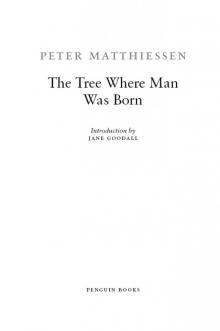 The Tree Where Man Was Born
The Tree Where Man Was Born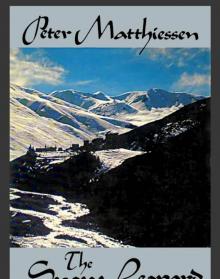 The Snow leopard
The Snow leopard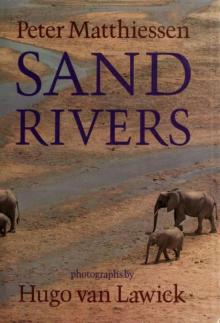 Sand Rivers
Sand Rivers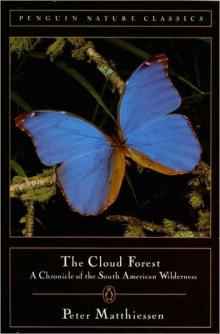 The Cloud Forest
The Cloud Forest Sal Si Puedes (Escape if You Can)
Sal Si Puedes (Escape if You Can) Far Tortuga
Far Tortuga Men's Lives
Men's Lives On the River Styx: And Other Stories
On the River Styx: And Other Stories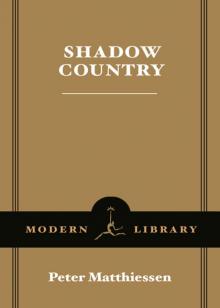 Shadow Country
Shadow Country At Play in the Fields of the Lord
At Play in the Fields of the Lord Lost Man's River
Lost Man's River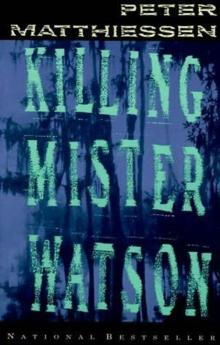 Killing Mister Watson
Killing Mister Watson On the River Styx
On the River Styx